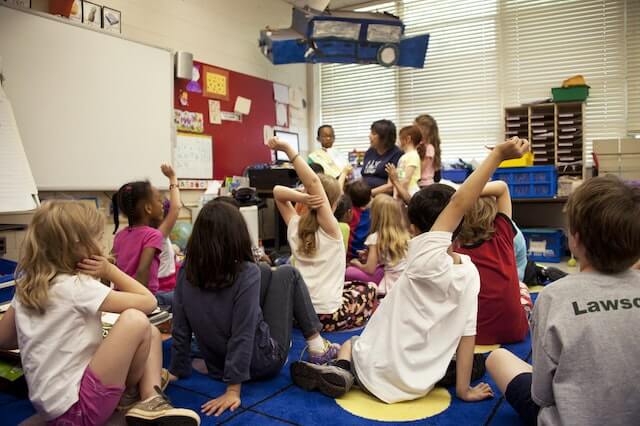How can school violence be prevented?

Between 2007 and 2013, there were an average of 1,471 school-related homicides each year in the US – that’s one death every 20 hours! To put this into perspective, that’s more deaths annually than car accidents. School violence doesn’t discriminate – it affects students of all ages and backgrounds. In this article, we’re going to explore some ways that schools can prevent school violence from taking place.
What is school violence?
In general, school violence is any act of physical aggression or threat of aggression on campus, in which a student or group of students engages in violence against another student or group of students. Violence can take many different forms, from simple pushing and shoving to more serious acts such as stabbing and shooting.
There is no one answer to how school violence can be prevented, as it depends on factors such as the individual school climate, the type of students enrolled there, and local laws. However, some measures that schools can take to reduce violence include creating a safe and secure environment for students, providing resources and support to those who are struggling with mental health issues, and engaging in educational programming that discusses respectful behavior.
Types of school violence
There are many types of school violence. Some examples are physical violence, verbal abuse, social exclusion, cyberbullying, and harassment.
Physical Violence: This is the most common type of school violence. It includes hitting, punching, kicking, and throwing objects. Physical violence can cause serious injuries and can even lead to death.
Verbal Abuse: Verbal abuse includes calling someone names, making threats, and spreading rumors. It can be very hurtful and intimidating.
Social Exclusion: Social exclusion occurs when someone is ignored or excluded from participation in activities or groups. It can make someone feel isolated and alone.
Cyberbullying: Cyberbullying is a type of school violence that involves sending hurtful messages online. It can be very stressful and demoralizing for the victim.
Causes of school violence
Prevention of school violence is a challenge that has received much attention in recent years. However, the root causes of school violence are complex and multi-layered, and it is difficult to identify specific interventions that would be effective in preventing it.
Some experts believe that the root cause of school violence is the way in which schools are structured and operated. For instance, some argue that schools should be restructured so that they are more like traditional workplaces, with more rigorous discipline measures for students who misbehave. Others maintain that schools should focus more on social and emotional development instead of strictly punishing students for their behavior.
It is also important to remember that not all school shooters are strictly motivated by anger or revenge. School shooters can be influenced by a variety of factors, including peer pressure, mental health issues, and rural isolation. It is thus important to provide adequate support to students who may be struggling with these issues.
In spite of the challenges involved, there are a number of initiatives underway aimed at preventing school violence. For example, some schools are conducting pilot programs focused on reducing aggressive behavior among students. Additionally, groups such as the National Alliance to End School Violence have launched campaigns aimed at raising awareness about the dangers of school
Prevention methods of school violence
There are a variety of prevention methods that can be used to reduce the occurrence of school violence. Some of these methods include:
1) Educating students on the dangers of school violence and its consequences.
2) Counseling students who are exhibiting violent behavior.
3) Providing resources, such as mental health counseling, to students who may be struggling with emotional issues that could lead to violence.
4) Developing prevention programs for schools and communities.
5) Supporting legislation that would provide funding for more effective school violence prevention programs.
Causes of School Violence
There are a variety of factors that contribute to school violence, but some of the most common include:
– Poor social and emotional development
– Disruptive behavior in early childhood
– Substance abuse or mental health issues
– Gang involvement
– Parental absences or lack of support
– Poverty or financial insecurity
– Access to weapons or violent video games
How to Prevent School Violence?
It is not uncommon for school violence to occur. According to the National Crime Prevention Council, one in five high school students has been the victim of a physical attack on school property, and one in thirty-four students has been the victim of a physical attack at school.
There are a number of ways that schools can prevent school violence. One way is to develop and implement a safe school plan. This plan should include steps that will help prevent violence, such as increasing safety awareness, establishing rules and regulations, conducting regular crime monitoring, and providing support to victims.
Another way to prevent school violence is to create a positive environment for students. This means creating an environment where students feel safe and respected. It also means establishing rules and expectations that are fair and consistent.
Schools can also work with law enforcement to improve security measures. These measures may include installing surveillance cameras, hiring security personnel, and creating a code of conduct for students.
School Violence Prevention Tips:
1) Develop and implement a safe school plan that includes steps such as increasing safety awareness, establishing rules and regulations, conducting regular crime monitoring, and providing support to victims
Definition of School Violence
School violence can be defined as any act of physical aggression or violence that takes place within a school context. It can be verbal or physical, but it is most commonly physical.
Most school violence is committed by students against other students, but it can also be perpetrated by teachers or staff members against students. School violence can often lead to long-term psychological consequences for the victims and their families.
There are many ways to prevent school violence from happening. Some of the most important things schools can do include:
1. Creating a safe and secure environment for all students, including those who are traditionally at risks of being targeted, such as students with disabilities or those who are new to the school setting
2. Providing clear and concise information about school policies and procedures related to bullying and harassment
3. Establishing effective disciplinary procedures which take into account the unique characteristics of each school community
Types of School Violence
There are a few different types of school violence that can be prevented.
Bullying is one type of school violence that can be prevented. Bullies target people because they feel weak or insecure. They use physical or verbal threats to make the person feel scared and intimidated. If bullying is not stopped, it can lead to more serious forms of violence.
Students who are experiencing emotional distress or who have mental health issues can also become violent. Sometimes these students might pick on other students because they feel like they are the only ones who can see them or hear them. This type of violence is often difficult to identify and stop, but it can be minimized if schools take steps to address any mental health concerns.
Another type of school violence that can be prevented is cyberbullying. Cyberbullying happens when someone harasses, threatens, or bullies someone online. This form of violence often goes undetected and can cause lasting damage to the victim’s reputation and self-esteem. Schools should work to create a safe environment for all students by creating policies against cyberbullying and promoting online safety education.
Schools should also provide resources for students who are experiencing any type of school violence. These resources might include counseling
Risk Factors for School Violence
Preventing school violence is a complex issue that requires collaboration between educators, community members, and law enforcement. However, identifying and addressing risk factors can help reduce the likelihood of violence occurring in schools.
One risk factor for school violence is educational level. Lower-income students, students of color, and students with disabilities are more likely to have lower levels of education, which may increase their vulnerability to violence in schools. In addition, students who are expelled or suspended from school are at an increased risk for violent behavior.
Another important risk factor for school violence is social isolation. Many perpetrators of school violence have documented histories of being victims of bullying or physical abuse when they were younger. As a result, these individuals often feel alone and lost in their schools.
Schools can also play a role in amplifying social isolation by providing inadequate support services such as mental health counseling or after-school programs. When these services are not available, students may turn to dangerous networks of friends for emotional support or find sources of drugs or weapons.
Finally, family dysfunction can be another significant risk factor for school violence. Research has shown that children who experience parental aggression or mental illness are at an increased risk for engaging in violent behavior
Prevention Strategies for School Violence
Prevention of school violence can be achieved through a variety of strategies, including:
-Breaking the cycle of violence: Violence begets violence, and often starts with small incidents that escalate. It is important to break the cycle of violence by addressing the root causes of aggression and excluding those who exhibit violent behavior from participating in school activities.
-Educating students about the dangers of school violence: By providing students with accurate information about the consequences of school violence, they are more likely to make informed decisions about whether or not to engage in violent behavior.
-Providing support and resources to victims of school violence: Victims of school violence need support to heal from their experiences and build a new life. Programs that provide resources such as counseling, financial assistance, and housing assistance can help them overcome trauma and rebuild their lives.
Introduction
School violence is a problem that has been on the rise in recent years, with more and more kids getting involved in fights and other forms of violence. In this article, we’ll discuss some of the ways that school violence can be prevented, and we’ll provide some tips for parents on how to raise children who are not prone to violence.
Causes of School Violence
School violence can be prevented by identifying and addressing the root causes. Some of the most common causes are:
Social issues: Children who are raised in chaotic homes or neighborhoods are more likely to engage in disruptive behavior at school. Bullying and peer pressure also play a role in increasing the likelihood of violence.
Individual factors: Some children are more prone to violence because they have a history of violence or aggression in their homes or neighborhoods, or they have a mental illness that makes them violent.
Educational issues: Schools can play an important role in preventing school violence by providing a safe and productive environment for students. However, many schools do not have adequate security or resources to deal with incidents of violence.
Prevention Methods
School violence can be prevented through implementing measures such as:
1. Preventing school shootings:
This could include improving security measures such as metal detectors and increased police presence throughout schools. It could also involve positive disciplinary practices, such as issuing consequences for violent behavior that is not criminal in nature.
2. Educating students on the dangers of gangs:
Gangs can be a contributing factor to school violence, and by educating students on the dangers of gangs, they may be more likely to refuse membership when offered. Additionally, providing resources to families that are at risk of being influenced by gangs may help reduce gang-related violence in schools.
3. Promoting healthy relationships:
Relationships between students can also play a role in causing or contributing to school violence. If relationships are not healthy, students may be more prone to violence towards others. By promoting healthy relationships within schools, it may be easier to prevent school violence from occurring.
Conclusion
There is no one-size-fits-all answer to preventing school violence, as each school and community faces unique challenges and opportunities. However, many strategies have been shown to be effective at reducing violence in schools, including investing in education and mental health programs, providing safe and healthy environments for students, engaging communities in crime prevention work, and supporting positive youth development. In the end, it’s important that we work together to find solutions that will work best for our individual schools and communities.






